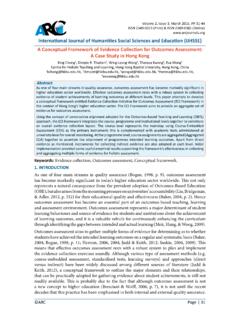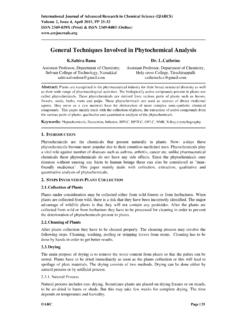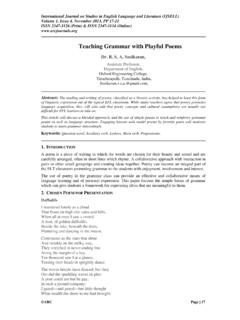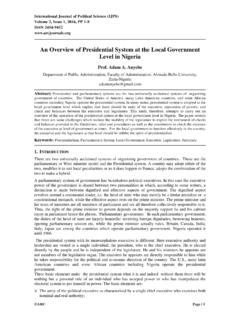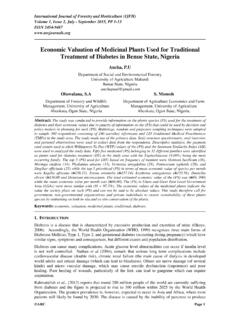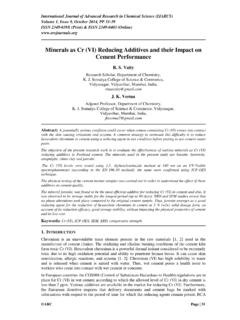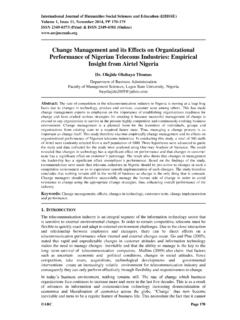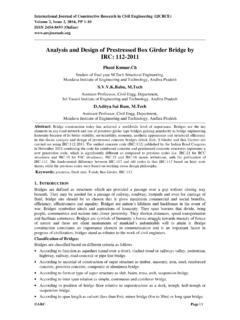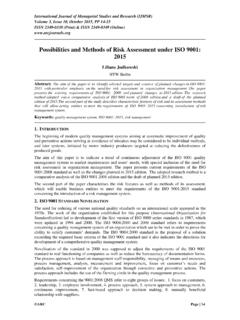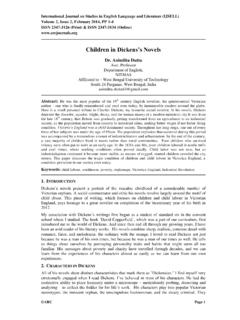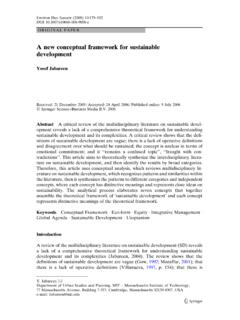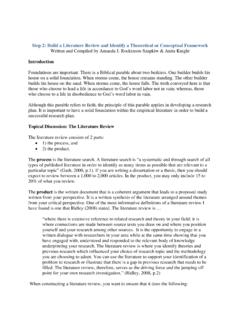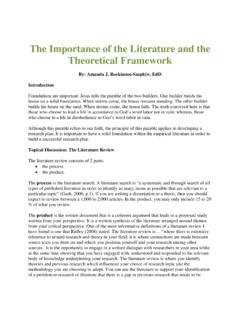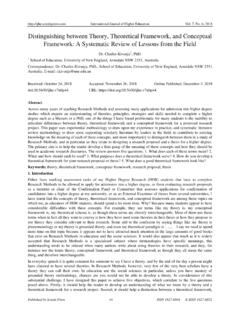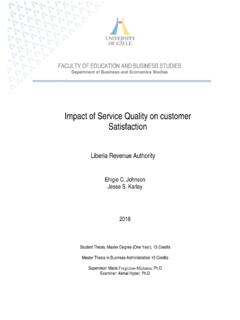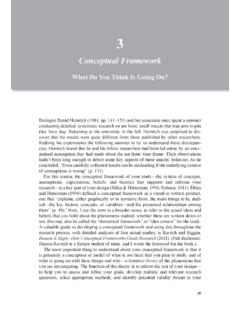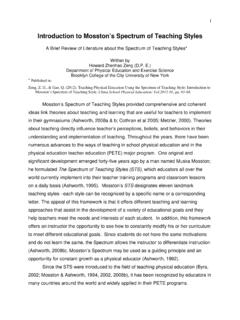Transcription of LEARNING ORGANIZATION–Conceptual and Theoretical …
1 Volume 2, Issue 4, April 2015, PP 93-98. ISSN 2349-0373 (Print) & ISSN 2349-0381 (Online). International Journal of Humanities Social Sciences and Education (IJHSSE). LEARNING organization conceptual and Theoretical Overview Dr Saeeda dawoood Sindh Madressatul Islam University Karachi Dr Mammona Hamdard University Dr Fahmeeda Federal Urdu University Dr Aijaz Ahmed Karachi University Abstract These days we are working in global era and the globalization putting lots of effect on working requirement and conditions in every field or organization in this scenario, all types of organization , must be LEARNING organizations. The globalization and the competition influence the procedure of working of organizations, where only those organizations can succeed which provided LEARNING environment. The aim of the paper is to give an overview of LEARNING organization on the basis of conceptual and Theoretical framework .
2 The paper discusses the concept of LEARNING organization , characteristics of LEARNING organization , process of making LEARNING organization and selected activities of a LEARNING organization . 1. introduction . LEARNING is the life time process and for socialization LEARNING is a key factor. Social adjustment is not possible without LEARNING process. LEARNING is essential element for every field of life. The LEARNING process is one of the foremost basics for success of any organization as well. The LEARNING organization is a comparatively new concept based on the concept of organizational LEARNING . Furthermore, the LEARNING organization is a existing management approach. It defines how an organization should activate in the ever-changing business environment Organizational LEARNING is a perpetual process of organizational change which implies innovation and development in manufacturing, services, client mind etc.
3 This procedure happens as a result of new knowledge which the organization acquires constantly (Petkovic 2008). 2. A LEARNING organization . A LEARNING organization is a group of people who have wicker a constant, enhanced ability to learn into the corporate culture, an organization in which LEARNING processes are analyzed, screened , build up, and united with set aims and goals. A LEARNING organization moves away from simple employee training into organizational problem solving, innovation, and LEARNING . For instance, in a LEARNING organization , when a creation is bad, instead of just crumbing it, the employees discover the grounds of the problem and develop solutions to avert it from happening yet again. In a LEARNING organization , the center point is on a company's only appreciating asset-its people. Ideal organization always provides the LEARNING environment where individual learn from each other.
4 Every employ try to enhance and develop the professional skills .Management give opportunity to employ to enhance their professional capacity. A LEARNING organization is one in which people at all levels individually are continually increasing their capacity to produce results they really care about . (David Bohm address on LEARNING -Org Dialog on LEARNING Organizations 2002). ARC Page | 93. Dr Saeeda dawoood, et al. Peter Senge defined a LEARNING organization as a place where people continually expand their capacity to create results they truly desire, where new and expansive patterns of thinking are nurtured, where collective aspiration is set free and where people are continually LEARNING how to learn . A LEARNING organization has been defined by Watkins and Marsick (1994) as one that learns continuously and can transform itself as it empowers the people, encourages collaboration and team LEARNING , promotes open dialogue, and acknowledges the interdependence of individuals and the organization .
5 Senge (1990) sees a LEARNING organization as one where people continually expand their capacity to create the results they truly desire, where new and expansive patterns of thinking are nurtured, where collective aspiration is set free, and where people are continually LEARNING how to learn together . 3. THE DEVELOPMENT OF A LEARNING organization . Organizations do not physically build up into LEARNING organizations there are processes of making a LEARNING organization . Humanist views support the essence of the LEARNING organization as individuals struggle to learn and change. For LEARNING to occur, individuals must courageously take responsibility as they confront personal transitions. Providing nourishing environments to meet human needs will enhance LEARNING (O'Hara, 1996). The processes of making a LEARNING organization challenges employees and communities to use their cooperative intelligence, ability to learn, creativity, transfer of knowledge continuous professional development.
6 Honey & Mumford develop LEARNING Pyramid This model shows clearly that individual LEARNING and/or self-development must underpin the LEARNING organization . Illustrated by the Authors International Journal of Humanities Social Sciences and Education (IJHSSE) Page | 94. LEARNING organization conceptual and Theoretical Overview. 4. DISTINCTIVENESS LEARNING organization . According to Peter Senge, there are five characteristics of LEARNING organization : System Thinking, Personal Mastery, Mental Models, Shared Vision and Team LEARNING . Systems Thinking Prepare to appreciate patterns and realization as an alternative of isolated events. The System Thinking need some disciplines to make active a LEARNING organization realization, to interconnect the entire team and to avoid blaming each other and to understand the problems may occur on the actions taken during operations.
7 Personal Mastery It is a self-commitment for life time LEARNING and life form a part of a LEARNING organization . each member tries to be the most excellent person and struggle for assurance and excitement and have to be more realistic for the future. The Mental Models The self-reflection process starts for the implementation, where everyone has to be in deeply insight for generalization and structuring the organizations model. Sharing thoughts / Visions Individuals have rights to share original ideas, proposals and visions because, the each distinct has the diverse visionary aspect of a particular segment of operation. The LEARNING Team Each team member is gluttonous to learn and share their ideas between rest of the members which surge the credibility and creativity of employees which ultimately diversify the organizations structure and helps to achieve the organizational goal.
8 5. DIFFERENCES BETWEEN A TRADITIONAL VIEW OF AN organization AND A LEARNING . organization . The McKinsey 7-S framework present a systems outlook for unfolding the main dissimilarities between a traditional perception of an organization and a LEARNING organization . McKinsey 7s model is a device that analyzes the design of organizational by looking at 7 key internal elements: strategy, structure, systems, shared values, style, staff and skills, in order to identify if they are effectively aligned and allow organization to achieve its objectives.. Seven key elements of an organization are identified by McKinsey 7-S framework . McKinsey divides these elements into hard elements and soft elements. These hard and soft elements are very important and play dynamic role if the organisation is going to be successful. Table below illustrates these elements into hard elements and soft elements.
9 Hard Elements Soft Elements Strategy Shared Values Structure Skills System Style Staff Under the McKinsey model, which recognizing the relations between above seven areas and shape of the model emphasizes interconnectedness and interrelations of the elements. International Journal of Humanities Social Sciences and Education (IJHSSE) Page | 95. Dr Saeeda dawoood, et al. The model can be applied to many situations and is a valuable tool when organizational design is at question. The most common uses of the framework are: To assist organizational change. To facilitate implement new strategy. To recognize how each area may change in a future. To facilitate the merger of organizations. 6. ACTIVITIES FOR TRANSFORMING organization INTO A LEARNING organization . Problem solving in a organized approach Systematical Thinking Insisting on data based decision rather than supposition Using statistical tools Give confidence testing with new approaches: Guarantee flow of new ideas Inducement for risk taking Projects Demonstration LEARNING from own experiences LEARNING from past history Recognition of the value of productive failure instead of unproductive success LEARNING from the experiences LEARNING from the best practices of others Enthusiastic scrounge Quick Transfer of knowledge and professionally throughout the organizationReports Visits Personnel rotation programs Professional Training programs International Journal of Humanities Social Sciences and Education (IJHSSE) Page | 96.
10 LEARNING organization conceptual and Theoretical Overview. Give constant LEARNING opportunities. Use LEARNING approach to reach their goals. Association of individual performance with organizational performance. Support people to share openly and take risks. Continuously aware of and interact with their environment. 7. CONCLUSION. An organization that smoothens the progress of LEARNING of its members and has the ability to continuously grow and alter itself can be termed as a LEARNING organization . Members of the organization continuously put their best efforts to increase their tendencies to learn and grow. A LEARNING organization is one in which all the members work unanimously to give the best possible outcome. LEARNING organization is relatively newer concept which is based upon the Organizational LEARNING concepts. Such an organization tends to practice new and modern ways of continuous LEARNING .
